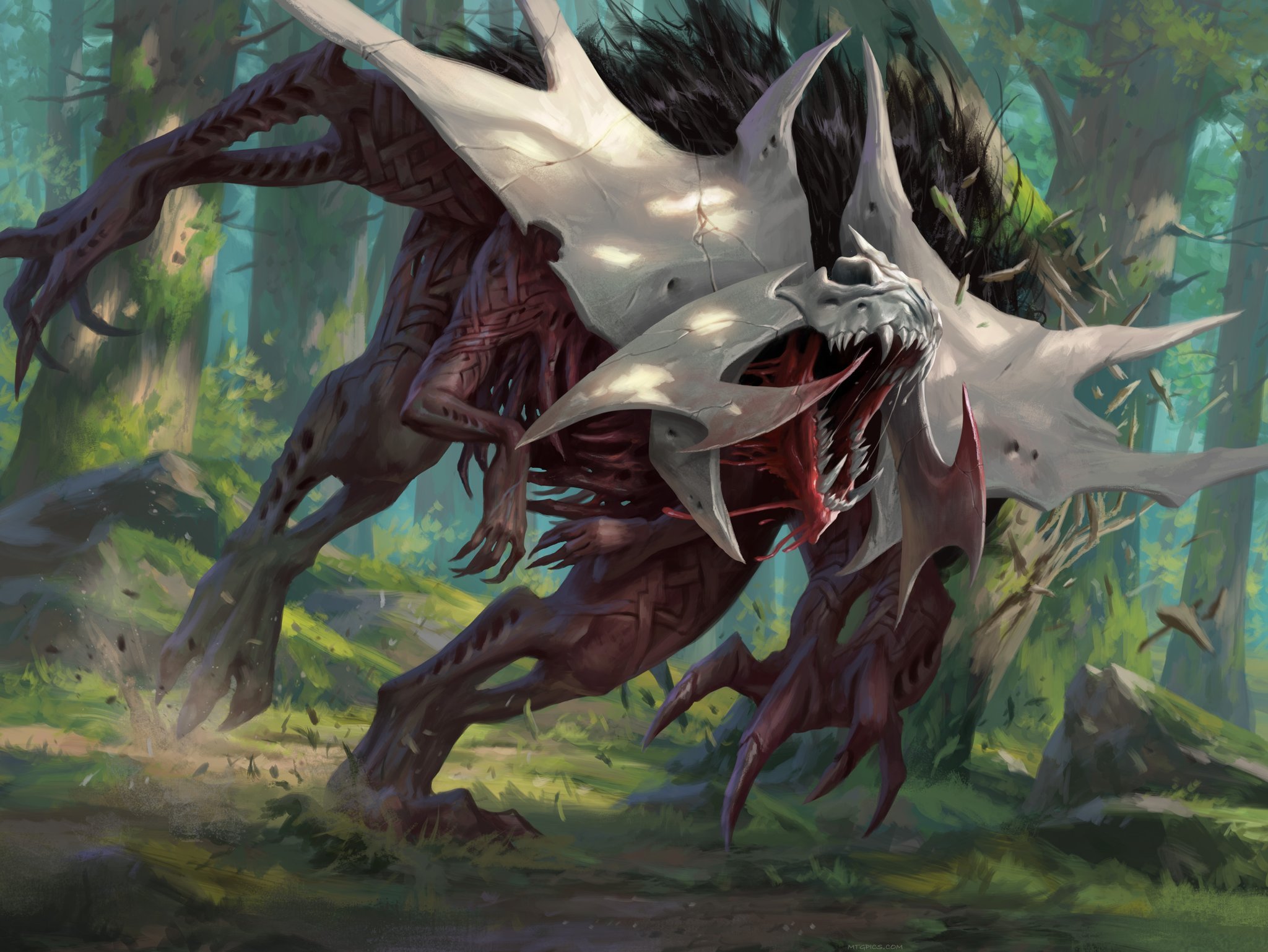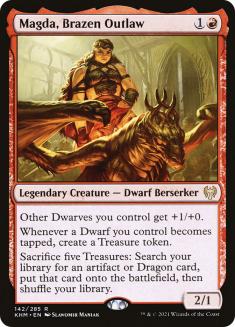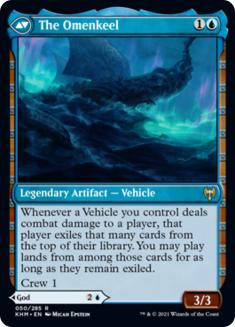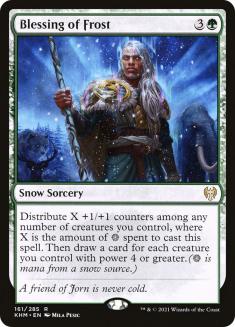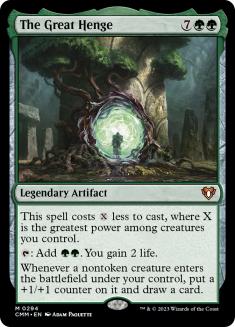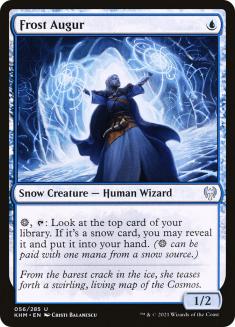Early Kaldheim preview season was slow to get my creative juices flowing but the tail end hit just right. As more pieces were revealed, I was able to start putting some excellent decklists together. I’m happy with where the set ended up, at least from a Standard perspective.
There are other decks I want to try, namely the Rakdos Midrange deck I wrote about featuring Egon, God of Death and several decks featuring Reidane, God of the Worthy, but I wanted to present some brand-new GerryT decklists.
Creatures (31)
- 2 Gilded Goose
- 4 Lovestruck Beast
- 2 Questing Beast
- 4 Edgewall Innkeeper
- 4 Bonecrusher Giant
- 4 Kazandu Mammoth
- 3 Magda, Brazen Outlaw
- 4 Goldspan Dragon
- 4 Jaspera Sentinel
Lands (19)
Spells (10)

Standard has had many problems over the last few months, many of which revolved around absurd Turn 4s that involved The Great Henge, Embercleave, Into the Story, or Genesis Ultimatum creating an insurmountable advantage. Part of the problem was the lack of aggressive strategies. Although this sort of deck isn’t a typical aggressive deck, it will ideally create a wide battlefield by Turn 3. It forces the fundamental turn to move up, which might be enough to shift the dynamic of Standard.
Bryan Gottlieb did a wonderful job explaining how to use Jaspera Sentinel alongside Magda, Brazen Outlaw to fuel Goldspan Dragon. Cheap mana generators tend to be the best thing you can be doing in any given format and these don’t appear to be any different.
Lovestruck Beast and Edgewall Innkeeper provide the early bodies necessary for Jaspera Sentinel without you having to invest much. As Bryan Gottlieb mentioned earlier this week, Jaspera Sentinel is a “bad” Magic card. However, we can’t always rely on raw power. Sometimes, power comes from synergy or mana acceleration. Loam Dryad got a bad rap but that was because the enablers didn’t exist. Innkeeper was rarely attacking or blocking anyway, so we aren’t losing anything by using it to fuel Jaspera Sentinel. It’s perfect.
Five mana on Turn 3 is the goal. If I wanted to maximize that aspect, I could play more Gilded Goose or Magda. There’s probably a version that could benefit from that direction but it would involve moving away from Questing Beast and Embercleave and adding a different engine. This is a hedge that still manages to provide raw power and speed, which is usually how these decks settle anyway.
The best way your opponent can attack you is by restricting your resources. In theory, that should work and it does but only if you don’t have massive amounts of card advantage. Think about using Dark Ritual to fuel a Turn 1 Phyrexian Negator. If your threat gets removed with a Swords to Plowshares, you have very few resources. However, if you follow it up with Necropotence, you don’t care.
If we had another way to tap Magda without getting into combat, then I could see a fourth copy. That would probably require adding blue for The Omenkeel, which is perfectly reasonable.
You can also build a more consistent, inherently powerful version of the same deck but you won’t have the potential explosiveness. Right now, we need something to break Standard’s paradigm and now we have the tools.
This is just one of many decks based around Goldspan Dragon that I’m going to try. It’s also not my only Jaspera Sentinel deck.
Creatures (26)
- 4 Gilded Goose
- 4 Lovestruck Beast
- 4 Wicked Wolf
- 3 Feasting Troll King
- 3 Tangled Florahedron
- 4 Kazandu Mammoth
- 4 Jaspera Sentinel
Lands (22)
Spells (12)

Maybe this is too similar to the above Gruul decklist or maybe it’s boring because it’s a deck that already exists. However, Blessing of Frost could help revitalize the archetype as a redundant engine alongside The Great Henge. They want the same thing and also help each other both ways.
The main deckbuilding decisions I struggled with involved the manabase. Do we play more Snow-Covered Forests or Castle Garenbrig? Bonders’ Enclave or Faceless Haven? Go hard on DFCs or no? I’m not convinced I got it right.
Regardless, people should have been playing a Fabled Passage in this deck. Not only are there Kazandu Mammoth synergies, Vivien, Monsters’ Advocate can also benefit from the shuffle. Since we’re playing a low number of Castle Garenbrigs, the danger of having an opening hand with Castle and Fabled Passage instead of a Forest is minimal. It’s close to free, especially with such a high land count.
You could play a more aggressive version of Mono-Green as well. However, there are very few reasons to do so when you can be aggressively slanted with multiple engines. Mono-Green Food makes for more consistent Blessing of Frosts and Castle Garenbrig is rather important for Feasting Troll King though. This deck isn’t without its issues.
Maybe In Search of Greatness is busted in a different version of this deck but I’d rather focus on Blessing of Frost at the moment.
Creatures (9)
Planeswalkers (1)
Lands (25)
Spells (25)

Despite having a card that can double your mana, Sultai Midrange❄ is an inherently fair deck. You’re trying to play a fair game based on attrition and those strategies didn’t fare particularly well last season. Thankfully, the snow cards give you a reason to try that sort of strategy again.
You can build almost an entirely snow-based deck if you wanted to. Frost Augur is a potentially powerful engine, at least if you can hit. If you’re short on mana, you can use Mazemind Tome to scry in combination with Frost Augur. It’s not much but it will come up.
Priest of the Haunted Edge is perfect! You finally have a reason to cast Kaldring, the Rimestaff instead of Jorn, God of Winter. Frost Augur is basically a must-kill threat, so that helps Kaldring’s case too. Obviously there are some issues with Priest but it will do its job and can lock opponents out in the late-game.
Blood on the Snow is powerful but overrated. I like it, especially because it has some powerful, game-swinging applications in the mid-game. Sadly, it’s not great against everyone and is too slow to carry by itself. You’ll need early interaction.
Similarly, Draugr Necromancer is a speculative inclusion. It’s not nearly as good as Kalitas, Traitor of Ghet. Lifelink mattered, it hosed the very popular Rally the Ancestors deck, and it made Zombie tokens for free rather than costing you mana. You could argue the formats were slower and more susceptible to a card like Kalitas back then too.
I’m fairly certain that Draugr Necromancer isn’t very good but I’m trying to lean on the snow theme. I want my Frost Augurs to hit and I want cards to return with Kaldring.
You could potentially use self-mill or a discard outlet to deposit Ugin, the Spirit Dragon into the graveyard and get back with Blood in the Snow as early as Turn 5. That may or may not be worth it but it’s worth keeping in mind for the future.
Fabled Passage will get you a Snow-Covered land but doesn’t count for Frost Augur, so maybe it’s not worth it. I worry that the mana won’t be good enough otherwise. Shimmerdrift Vale is roughly the same thing in the early turns but it’s worse late. It’s also worse than a random two-color snow land.
Cultivate and Fabled Passage are weird. If games go long, they will thin your deck of snow permanents, making Frost Augur less likely to hit. Usually, deck-thinning isn’t something you should be concerned about, but if our hit rate is already low, you could start to feel it later in the game. That said, I’m going to lean on the side of playing the best cards regardless and see where it takes me.
Frost Augur will also get worse in post-sideboard games but there’s very little avoiding that.
Creatures (7)
Planeswalkers (1)
Lands (33)
Spells (39)

Yorion, Sky Nomad decks aren’t something I tend to gravitate toward. Kaldheim offers little for this particular version of the archetype but it’s enough for me to get some enjoyment from the mindless loop of playing this sort of deck. Kill stuff, gain card advantage, blink your permanents, win eventually.
Binding the Old Gods is the new inclusion that makes me think Abzan Blink (Yorion) will be a fine place to be in the metagame. Elspeth Conquers Death loops tend to beat up on smaller midrange decks and this card is somehow an even better fit for the archetype.
Burning-Rune Demon is cool, but if you’re able to spend six mana and not immediately lose, you’re already in a fine position. Using it to find the perfect card and a Bala Ged Recovery is cute but probably win-more. There are scenarios in midrange mirrors where that sort of situation allows you to go over the top but I doubt it will be entirely necessary.
The thing is, you can get what you need from Eerie Ultimatum or Ugin most of the time anyway.
I’ve saved the best for last.
Creatures (21)
- 4 Lotus Cobra
- 4 Bonecrusher Giant
- 4 Dryad of the Ilysian Grove
- 2 Glasspool Mimic
- 3 Vorinclex, Monstrous Raider
- 4 Goldspan Dragon
Planeswalkers (3)
Lands (24)
Spells (12)

We’re building our own Escape to the Wilds and I’m not unhappy about it.
Dryad of the Ilysian Grove was already solid in these decks and gets even better when you have access to a bunch of extra resources thanks to Showdown of the Skalds. Showdown would play better with a lower mana curve but I want to try this first. If it doesn’t work out, then we can try Magda, Jaspera Sentinel, and less top-end. Either way, there’s something powerful here.
Vorinclex, Monstrous Raider is going to create some of the most absurd game states in Standard. It allows you to ultimate Ugin immediately. If you find another Ugin from the draw-seven, you’re probably going to put your entire deck onto the battlefield.
Unfortunately, if you manage to Genesis Ultimatum into Vorinclex, Monstrous Raider and Ugin, you won’t get double counters. Thankfully, that means you put an Ugin onto the battlefield and are probably doing just fine.
We used to need Kenrith, the Returned King or some other nonsense to kill immediately but this deck has enough incidental haste that you probably don’t need it. Plus, there are Ugin ticks and +1/+1 counters from Showdown of the Skalds.
Kaldheim offers a few different ways to get the game started on Turn 1. Usher of the Fallen, Jaspera Sentinel, Frost Augur, Ascendant Spirit, and Throne of Death should all contribute to Standard being a little faster. Various sources of fast and explosive mana could also help contribute to the demise of the old Standard decks, which would be a nice change of pace.

